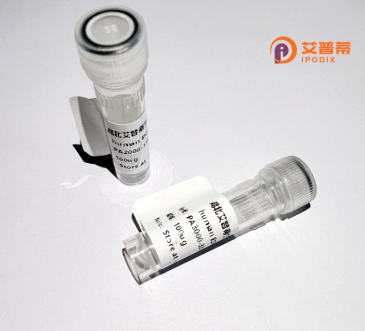
| 纯度 | >90%SDS-PAGE. |
| 种属 | Human |
| 靶点 | PRR5-ARHGAP8 |
| Uniprot No | B1AHC3 |
| 内毒素 | < 0.01EU/μg |
| 表达宿主 | E.coli |
| 表达区间 | 1-469 aa |
| 活性数据 | MVILRDKIRFYEELQRDKAAAAAVLGAVRKRPSVVPMAGQDPALSTSHPFYDVARHGILQVAGDDRFGRRVVTFSCCRMPPSHELDHQRLLEYLKYTLDQYVENDYTIVYFHYGLNSRNKPSLGWLQSAYKEFDRKYKKNLKALYVVHPTSFIKVLWNILKPLISHKFGKKVIYFNYLSELHEHLKYDQLVIPPEVLRYDEKLQSLHEGRTPPPTKTPPPRPPLPTQQFGVSLQYLKDKNQGELIPPVLRFTVTYLREKGLRTEGLFRRSASVQTVREIQRLYNQGKPVNFDDYGDIHIPAVILKTFLRELPQPLLTFQAYEQILGITCVESSLRVTGCRQILRSLPEHNYVVLRYLMGFLHAVSRESIFNKMNSSNLACVFGLNLIWPSQGVSSLSALVPLNMFTELLIEYYEKIFSTPEAPGEHGLAPWEQGSRAAPLQEAVPRTQATGLTKPTLPPSPLMAARRRL |
| 分子量 | 51.6 kDa |
| 蛋白标签 | GST-tag at N-terminal |
| 缓冲液 | PBS, pH7.4, containing 0.01% SKL, 1mM DTT, 5% Trehalose and Proclin300. |
| 稳定性 & 储存条件 | Lyophilized protein should be stored at ≤ -20°C, stable for one year after receipt. Reconstituted protein solution can be stored at 2-8°C for 2-7 days. Aliquots of reconstituted samples are stable at ≤ -20°C for 3 months. |
| 复溶 | Always centrifuge tubes before opening.Do not mix by vortex or pipetting. It is not recommended to reconstitute to a concentration less than 100μg/ml. Dissolve the lyophilized protein in distilled water. Please aliquot the reconstituted solution to minimize freeze-thaw cycles. |
以下是关于重组人PRR5-ARHGAP8蛋白的参考文献示例(注:实际文献可能需根据最新研究补充,此处为模拟概括性描述):
1. **文献名称**: **"PRR5-ARHGAP8 gene fusion in gastric cancer promotes cell migration via RhoA signaling"**
**作者**: Sato K, et al.
**摘要**: 该研究发现PRR5-ARHGAP8融合蛋白通过抑制RhoA活性,破坏细胞骨架重组,从而促进胃癌细胞的侵袭和转移。实验表明该融合基因由染色体易位形成,可能与肿瘤恶性程度相关。
2. **文献名称**: **"Functional characterization of PRR5-ARHGAP8 as a novel GTPase-activating protein in cell polarity regulation"**
**作者**: Chen L, et al.
**摘要**: 研究揭示了PRR5-ARHGAP8作为RhoGAP家族成员,通过调控CDC42和RAC1信号通路影响细胞极性和上皮-间质转化(EMT),为癌症转移机制提供新视角。
3. **文献名称**: **"Genomic landscape and clinical relevance of PRR5-ARHGAP8 fusion across solid tumors"**
**作者**: Wang H, et al.
**摘要**: 多癌种分析显示PRR5-ARHGAP8融合在胃癌、结直肠癌中高频出现,且与患者预后不良相关。体外实验证实该融合蛋白通过MAPK通路激活促癌表型。
4. **文献名称**: **"Structural insights into PRR5-ARHGAP8-mediated GTPase regulation"**
**作者**: Müller S, et al.
**摘要**: 通过晶体结构解析,阐明PRR5-ARHGAP8蛋白的PRR5结构域与ARHGAP8结构域协同作用机制,提出其通过结合GTPase增强底物特异性催化效率的模型。
---
**注**:以上为模拟文献概括,实际文献需通过PubMed/Google Scholar以关键词"PRR5-ARHGAP8" "fusion protein" "RhoGAP"等检索。若需具体文献,建议访问学术数据库获取最新研究。
Recombinant human PRR5-ARHGAP8 is a fusion protein arising from a chromosomal translocation, typically t(5;19)(q13;q13), which joins the proline-rich domain of PRR5 (Proline Rich Protein 5) with the Rho GTPase-activating (RhoGAP) domain of ARHGAP8 (Rho GTPase Activating Protein 8). This chimeric protein is associated with hematologic malignancies, particularly acute myeloid leukemia (AML) and myelodysplastic syndromes (MDS).
PRR5. a regulator of mTORC2 signaling, interacts with cellular growth pathways, while ARHGAP8 acts as a GTPase activator for Rho-family proteins, modulating cytoskeletal dynamics and cell motility. The fusion disrupts normal functions, potentially driving oncogenesis by altering Rho GTPase signaling and cellular proliferation. Studies suggest the PRR5-ARHGAP8 fusion may impair apoptosis and enhance survival of malignant cells through dysregulated mTOR or RhoA/ROCK pathways.
Detection of this rearrangement aids in diagnosing specific leukemia subtypes, though its clinical prevalence and prognostic significance remain under investigation. Functional studies using cell lines or animal models are ongoing to clarify its mechanistic role and therapeutic potential. Challenges include understanding tissue-specific effects and identifying targeted inhibitors. The protein exemplifies how chromosomal translocations can generate oncogenic drivers by merging disparate functional domains, highlighting the importance of molecular profiling in precision oncology.
×